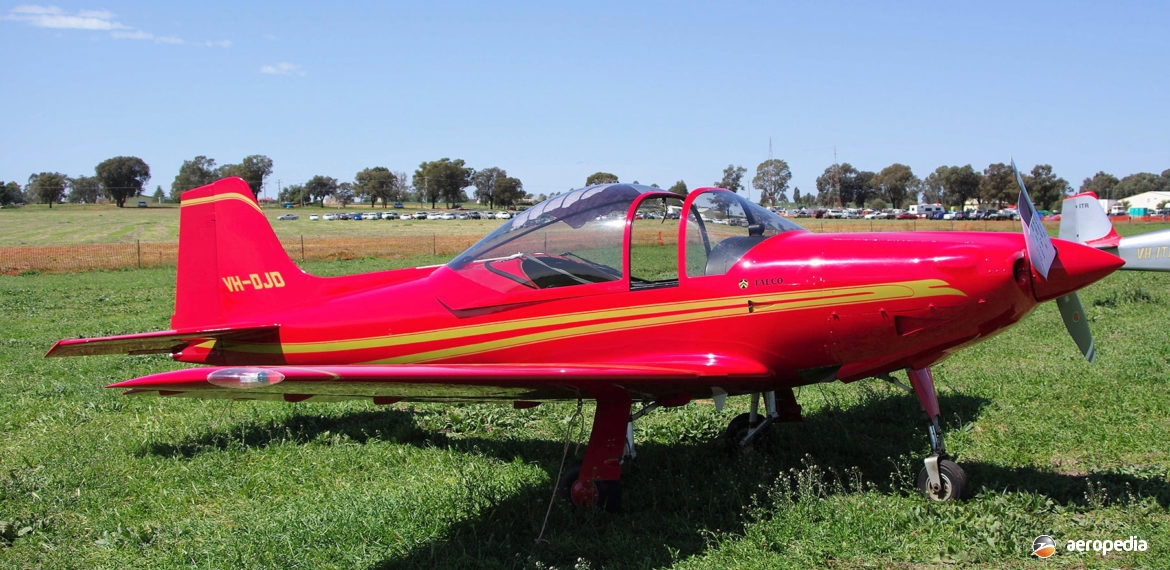Photograph:
Sequoia Falco F-8L VH-DJD (c/ N379) at Narromine, NSW in April 2007 (David C Eyre)
Country of origin:
Italy
Description:
Two-seat light touring monoplane
Power Plant:
(F-8L Falco)
One 112 kw (150 hp) Lycoming O-320-A four-cylinder horizontally-opposed air-cooled engine
Specifications:
- Wingspan: 8 m (26 ft 3 in)
- Length: 6.5 m (21 ft 4 in)
- Height: 2.27 m (7 ft 5¼ in)
- Wing area: 10 m² (107.64 sq ft)
- Max speed at sea level: 325 km/h (202 mph)
- Max cruising speed at 1,500 m (4,920 ft): 305 km/h (190 mph)
- Economical cruising speed: 249 km/h (155 mph)
- Initial rate of climb: 299 m/min (984 ft/min)
- Service ceiling: 5,800 m (19,030 ft)
- Max range: 1,400 km (870 miles)
- Empty weight: 520 kg (1,146 lb)
- Loaded weight: 780 kg (1,720 lb)
History:
The Falco series of monoplanes was originally designed by Stelio Frati, the prototype, known as the Frati F-8 Falco, flying for the first time on 15 June 1955 powered by a 67 kw (90 hp) Continental C-90 engine. Production was initiated of a series known as the F-8L Series I, these being fitted with a 104 kw (140 hp) Lycoming O-290-D2B engine. These production Series I aircraft had a slightly larger wing and were in fact built by Aviamilano.
After completion of ten aircraft, production was switched to the Series II, these having the Lycoming O-320-A engine, and 20 were built. Later a licence to manufacture the type was obtained by Aeromere Societa per Azioni, and this company produced the type as the F-8L America, these being essentially similar to the Series II. Further development led to the installation of the 119 kw (160 hp) variant of the O-320 engine, and these became known as the Super Falco Series IV, these being built by Laverda SpA, which took over the old Aeromere concern.
The Falco was of cantilever low-wing configuration, the airframe being basically of wood with plywood skin. The wing incorporated electrically actuated split flaps and all control surfaces were of metal construction. A retractable tricycle undercarriage was fitted, and dual controls were standard. In more recent times the Sequioa Aircraft Corporation of Richmond, Virginia, USA marketed plans and kits to build the Falco F-8L by amateur constructors, this incorporating significant improvements including increased fuel capacity, a more efficient exhaust system, improved engine induction system, propeller spinner and engine cowling of improved design, new instrument panel and electrical system. Either the 101 kw (135 hp) or 119 kw (160 hp) Avco Lycoming engines could be fitted.
Two Falco F-8Ls have been completed and flown in New Zealand: ZK-RNA (c/n 104), an Aviamilano-built machine, and ZK-TBD (c/n Design 606), a Sequoia kit. A number have been completed in Australia, including VH-NVA (c/n F.86), VH-DJD (c/n N.379), VH-SBD (c/n N.136), VH-FFB (c/n 1373), VH-LZD (c/n 1105) and VH-LZF (c/n Q.052).

